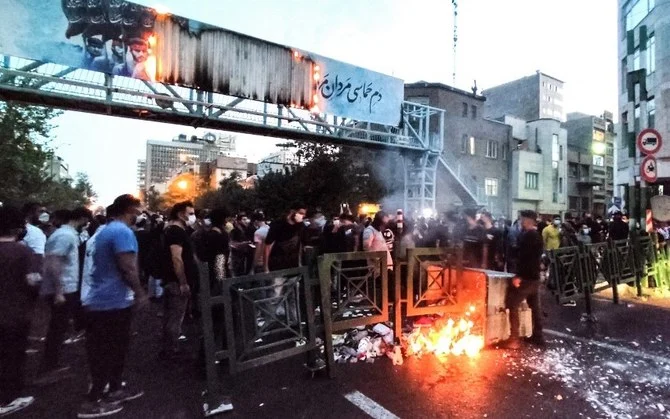
- ARAB NEWS
- 06 Jul 2025

Mass protests across Iran, now close to entering their third week, show no sign of abating, even though the government is using force in an attempt to crush them. With few independent journalists inside the country and with no internet link, it is difficult to know exactly what is happening. But what is certain is that what started as a small demonstration following the death in hospital on Sept. 16 of 22-year-old Mahsa Amini, three days after she was arrested by the so-called morality police for violating a law requiring women to wear headscarves fully hiding their hair, has led to one of the most serious revolts the Islamic Republic has ever faced.
The protests have spread to more than 40 towns and cities, with young Iranians openly calling for the toppling of the regime. In 2009, nationwide demonstrations broke out to protest the result of the presidential election. This time, Iranians are not only complaining about the high cost of living, unemployment and poor government services. Simply put, the people are fed up with the rule of the ayatollahs.
As to be expected, the Iranian leadership has decided to blame the Western media for instigating the protests and thus has demonstrated that it has lost touch with its own people. The most likely response will be to resort to force rather than appear weak and deliver concessions. Reports have talked of tens of fatalities and thousands of arrests. It will get messier in the coming days.
Iran’s problems are not the product of foreign conspiracies, as the regime claims. To begin with, more than 60 percent of Iran’s 80 million people are under 30 years of age and that poses a major challenge for any government that is unable to create decent jobs and provide high-quality services.
According to government figures, the unemployment rate for Iranians aged between 15 and 24 is about 24 percent, with an annual increase of no less than 2 percent. More than 90 percent of the Iranian youth are literate. And while the country has respectable gross domestic product growth — forecast by the World Bank to be 3.7 percent for 2022 — the fact is that currency devaluation and inflation have pushed the real poverty ratio to at least 50 percent. The inflation rate hovers at about 30 percent.
The regime will respond by blaming US sanctions for its economic woes. And that is partly true. But despite the sanctions, the Iranian economy is growing because Iran is able to sell most of its oil, mainly to China. In fact, figures show that Iranian crude exports in July rose by 110,000 barrels per day from June, to 810,000 bpd.
But where does the money go? According to a recent report by the Stockholm International Peace Research Institute, the Islamic Republic last year raised its military spending to $24.6 billion — an annual increase of 11 percent — and for the first time in two decades it is now among the world’s top 15 countries in terms of defense budget. Compare this to how much the government spends on education, for example. Iran’s public spending on education as a share of GDP was at 3.6 percent in 2020, down from 3.7 percent the previous year, according to the World Bank. For health, it was 6.7 percent of GDP in 2019, down from 8.46 percent in 2018.
It is difficult to estimate how much money Iran spends to support its proxies in Syria, Iraq, Lebanon and Yemen. But whatever the figure is, it must be in the billions of dollars — money that is badly needed back home. It is no secret that the government’s foreign military adventurism is extremely unpopular among a majority of Iranians.
In 2018, student protests broke out in the second most populous city in Iran, Mashhad, over socioeconomic hardships. The slogan, “Not Gaza, not Lebanon, I give my life for Iran,” was repeated by the protesters. And exporting the revolution has been one of the primary factors in souring ties between revolutionary Iran and its neighbors.
Any attempt to influence the course of the ongoing protests would only embolden the regime.
Osama Al-Sharif
But despite the West’s interest in following events in Iran, it would be wrong to interfere. The US does not have a credible record with that country. Any attempt to influence the course of the ongoing protests would only embolden the regime.
What is going on inside Iran is a matter that concerns the Iranian people and their right to choose their leaders and system of government. This applies to other nations as well. It is true that millions of Iranians are suffering and are now calling for an end to more than four decades of reactionary and often ruthless theocratic rule. But it is their struggle and any foreign interference would only play into the hands of the ayatollahs and the hundreds of thousands of armed men who are dependent on them.